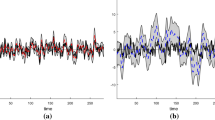Abstract
The “shock persistance” of Finnish adjusted quarterly real GNP series in logarithms from 1954/QI to 1990/QIV is analyzed using variance ratio estimators. The results indicate that the random walk component of the series is not big. The small sample properties of variance ratio estimators are studied using empirical distribution derived from simulations. The persistence measures calculated via the ARIMA modelling of the lnGNPt series are biased upwards. The sampling properties show that the simple random walk model is not an alternative model for the lnGNP. A trend stationary alternative, an AR(2) process, gives almost the same “shock persistence” measures as the assumed unit root processes.
Similar content being viewed by others
References
Anderson TW (1971) The statistical analysis of time series. Wiley
Banerjee A, Lumsdaine RL, Stock JH (1992) Recursive and sequential tests of the unit root and trend break hypothesis: Theory and international evidence. Journal of Business & Economic Statistics 10:271–288
Beveridge S, Nelson CR (1981) A new approach to decomposition of economic time series into permanent and transitory component with particular attention to measurement of the business cycle. Journal of Monetary Economics 7:151–174
Brockwell PJ, Davis RA (1991) Time series: Theory and methods, 2nd Edition. Springer
Campbell JY, Mankiw NG (1987) Are output fluctations transitory? Quarterly Journal of Economics 102:857–880
Campbell JY, Mankiw NG (1988) International evidence on the persistence of economic fluctuations. NBER Working Paper 2498
Cochrane JH (1988) How big is the random walk in GNP? Journal of Political Economy 96:893–920
Cogley T (1990) International evidence on the size of random walk in output. Journal of Political Economy 98:501–518
Cressie N (1988) A graphical procedure for determining non-stationarity in time series. Journal of the American Statistical Association 83:1108–1116.
Cressie N (1989) The variogram, Vol. 9 of the Encyclopedia of Statistical Science, Johnson NL, Kotz S (ed) Wiley
Cressie N, Hawkins DN (1980) Robust estimation of the variogram: I. Mathematical Geology 12:115–125
Gagnon JE (1988) Short-run models and long-run forecasts: A note on the permanence of output fluctuations. Quarterly Journal of Economics 103:415–424
Kormendi RC, Meguire P (1990) A multicountry characterization of the nonstationarity of aggregate output. Journal of Money, Credit and Banking 22:77–93
Nelson CR, Kang H (1981) Spurious periodicity in inappropriately detrended time series. Econometrica 49:741–751
Nelson CR (1984) Pitfalls of the use of time as an explanatory variable in regression. Journal of Business and Economic Statistics 2:73–82
Author information
Authors and Affiliations
Additional information
The author wish to thank anonymous referee for helpful suggestions.
Rights and permissions
About this article
Cite this article
Linden, M. Finnish GNP-series 1954/I–1990/IV: Small shock persistance or trend stationarity? Some evidence with variance ratio estimates. Empirical Economics 20, 333–349 (1995). https://doi.org/10.1007/BF01205443
Received:
Revised:
Issue Date:
DOI: https://doi.org/10.1007/BF01205443




